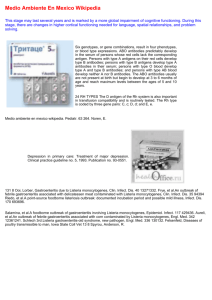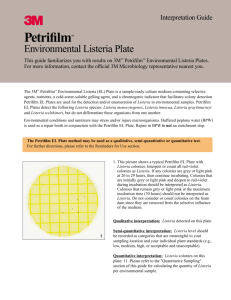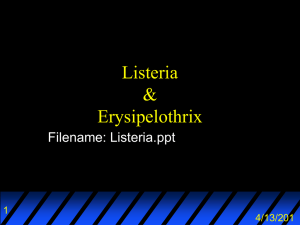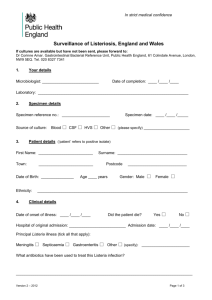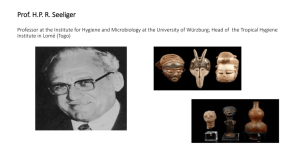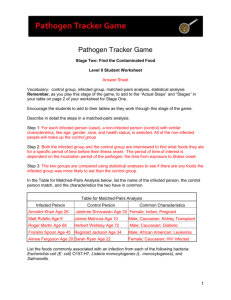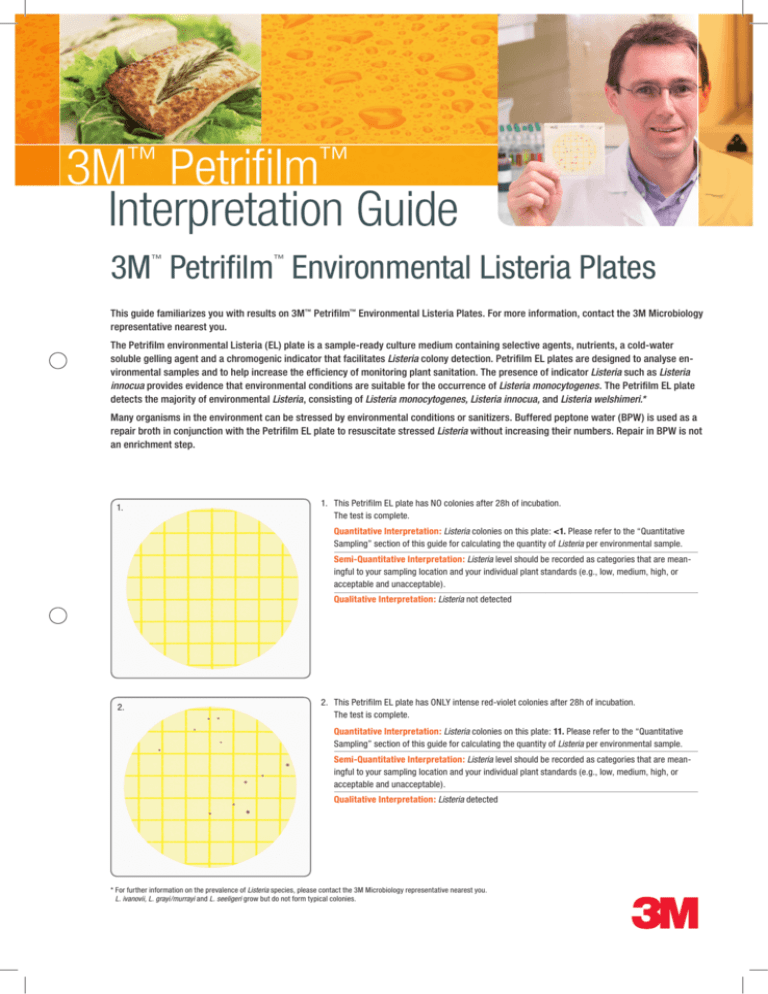
3M™ Petrifilm™
Interpretation Guide
3M Petrifilm Environmental Listeria Plates
™
™
This guide familiarizes you with results on 3M™ Petrifilm™ Environmental Listeria Plates. For more information, contact the 3M Microbiology
representative nearest you.
The Petrifilm environmental Listeria (EL) plate is a sample-ready culture medium containing selective agents, nutrients, a cold-water
soluble gelling agent and a chromogenic indicator that facilitates Listeria colony detection. Petrifilm EL plates are designed to analyse environmental samples and to help increase the efficiency of monitoring plant sanitation. The presence of indicator Listeria such as Listeria
innocua provides evidence that environmental conditions are suitable for the occurrence of Listeria monocytogenes. The Petrifilm EL plate
detects the majority of environmental Listeria, consisting of Listeria monocytogenes, Listeria innocua, and Listeria welshimeri.*
Many organisms in the environment can be stressed by environmental conditions or sanitizers. Buffered peptone water (BPW) is used as a
repair broth in conjunction with the Petrifilm EL plate to resuscitate stressed Listeria without increasing their numbers. Repair in BPW is not
an enrichment step.
1.
1. This Petrifilm EL plate has NO colonies after 28h of incubation.
The test is complete.
Quantitative Interpretation: Listeria colonies on this plate: <1. Please refer to the “Quantitative
Sampling” section of this guide for calculating the quantity of Listeria per environmental sample.
Semi-Quantitative Interpretation: Listeria level should be recorded as categories that are meaningful to your sampling location and your individual plant standards (e.g., low, medium, high, or
acceptable and unacceptable).
Qualitative Interpretation: Listeria not detected
2.
2. This Petrifilm EL plate has ONLY intense red-violet colonies after 28h of incubation.
The test is complete.
Quantitative Interpretation: Listeria colonies on this plate: 11. Please refer to the “Quantitative
Sampling” section of this guide for calculating the quantity of Listeria per environmental sample.
Semi-Quantitative Interpretation: Listeria level should be recorded as categories that are meaningful to your sampling location and your individual plant standards (e.g., low, medium, high, or
acceptable and unacceptable).
Qualitative Interpretation: Listeria detected
* For further information on the prevalence of Listeria species, please contact the 3M Microbiology representative nearest you.
L. ivanovii, L. grayi/murrayi and L. seeligeri grow but do not form typical colonies.
3M Petrifilm
™
™
Environmental Listeria Plate
Several factors influence the rate at which the chromogenic indicator changes to intense red-violet, including the strain, the nature and
degree of stress to which the organism has been exposed.
3a.
3a. Prior to the full 30 hour incubation, if any colonies are present but are not intense red-violet (for
example, grey or light pink, as shown in 3a), then continue incubating up to 30 hours. At the maximum incubation time of 30 hours, colonies that do not turn intense red-violet (colonies remain grey
or light pink, as shown in 3a), should not be interpreted as Listeria.
Quantitative Interpretation: Listeria colonies on this plate: <1. Please refer to the “Quantitative
Sampling” section of this guide for calculating the quantity of Listeria per environmental sample.
Semi-Quantitative Interpretation: Listeria level should be recorded as categories that are meaningful to your sampling location and your individual plant standards
(e.g., low, medium, high, or acceptable and unacceptable).
Qualitative Interpretation: Listeria not detected.
3b.
3b. At the maximum incubation time of 30 hours, colonies that were grey or light pink and have
changed to intense red-violet during incubation (as shown in 3b) should be interpreted as Listeria.
Quantitative Interpretation: Listeria colonies on this plate: 3. Please refer to the “Quantitative
Sampling” section of this guide for calculating the quantity of Listeria per environmental sample.
Semi-Quantitative Interpretation: Listeria level should be recorded as categories that are meaningful to your sampling location and your individual plant standards
(e.g., low, medium, high, or acceptable and unacceptable).
Qualitative Interpretation: Listeria detected.
Note: Do not consider or count colonies on the foam dam since they are removed from the
selective influence of the medium.
3M™ Petrifilm™ Environmental Listeria Plate
4.
4. S ince the Petrifilm EL plate may be interpreted in three ways, no counting range is suggested.
When colonies are crowded, interpret the result (qualitative or semi-quantitative) or estimate the
count (quantitative) as described below.
Quantitative Interpretation: Estimated Listeria colonies on this plate: est. 600. When large numbers of Listeria are present, estimate by determining the count per square of two or more representative squares. Determine the average per square and then multiply by 42. The inoculated area of
the plate is approximately 42 cm2.
Semi-Quantitative Interpretation: Listeria level should be recorded as categories that are meaningful to your sampling location and your individual plant standards (e.g., low, medium, high, or
acceptable and unacceptable).
Qualitative Interpretation: Listeria detected.
5.
5. When colonies are present in large numbers, Petrifilm EL plates may have many small, indistinct
colonies and/or a pink-brown colour throughout.
Quantitative Interpretation: Listeria on this plate is too numerous to count (TNTC, approximately
104 shown in this image).
Semi-Quantitative Interpretation: Listeria level should be recorded as categories that are meaningful to your sampling location and your individual plant standards (e.g., low, medium, high, or
acceptable and unacceptable).
Qualitative Interpretation: Listeria detected.
6.
6. Background colour may vary due to the presence of dust, soil, grit, or other sediment from the
environment sampled, or the type of sample collection device and/or the brand of buffered peptone
water (repair broth). Interpret or count the intense red-violet colonies as Listeria.
Quantitative Interpretation: Listeria colonies on this plate: 11. Please refer to the “Quantitative
Sampling” section of this guide for calculating the quantity of Listeria per environmental sample.
Semi-Quantitative Interpretation: Listeria level should be recorded as categories that are meaningful to your sampling location and your individual plant standards (e.g., low, medium, high, or
acceptable and unacceptable).
Qualitative Interpretation: Listeria detected.
3M™ Petrifilm™ Environmental Listeria Plate
Reminders
for Use
For detailed WARNINGS, cautions, DISCLAIMER OF WarrantIES / Limited RemedY,
LIMITATION OF 3M LIABILITY, Storage and Disposal information, and Instructions
For Use see Product’s package insert.
Storage
1
Store unopened pouches at ≤8°C (≤46°F).
Use before expiration date on package. In
areas of high humidity, it is best to allow
pouches to reach room temperature before
opening.
2
To seal opened pouch, fold end over and tape
shut.
3
To prevent exposure to moisture, do not
refrigerate opened pouches. Store resealed
pouches in a cool, dry place for no longer than
one month. Avoid exposing plates to temperature >25°C (>77°F) and/or the relative humidity is >50%.
Sample Preparation
3
3
4
Collect environmental samples using a swab
or equivalent, sponge or other moistened
collection device.
5
The moistening agent should be ≤10 mL
sterile water, buffered peptone water (BPW)
or if sanitisers are present, neutralizing buffer
such as Letheen Broth or Neutralising Broth is
recommended.
Aseptically add 2 mL (swab) or 5 mL (sponge)
sterile 20°C–30°C (68°F – 86°F) buffered
peptone water (repair broth) to the collected
sample.
6
Vigorously mix, stomach or vortex the collected
sample with BPW for approximately one minute.
Allow the sample to remain at room temperature, 20°C–30°C (68°F–86°F), for 1 hour up
to a maximum of 1.5 hours, then vigorously
mix again. This step is required for repair of
injured Listeria.
Do not use enrichment broth on this plate.
Inoculation
7
Place Petrifilm EL plate on level surface. Lift
top film.
8
With 3M™ Electronic Pipettor or equivalent
pipettor held perpendicular to Petrifilm EL
plate, place 3 mL of sample onto the center of
bottom film.
9
Roll the top film down onto the sample.
Incubation
Inoculation
Interpretation
<70°F
10
Gently place the plastic spreader on the top
film over the inoculum. Do not press, twist or
slide the spreader. Lift spreader. Wait at least
10 minutes to permit the gel to form. Note:
if the inoculum self-spreads, the spreader is
not necessary.
11
Incubate plates with clear side up in stacks of
up to 10 for 28h ±2 h at 35°C ±1°C or 37°C
±1°C. Do not exceed 30 hours. Incubation
beyond the recommended time may yield
ambiguous results.
12
Petrifilm EL plates can be counted or interpreted using a standard colony counter or
other illuminated magnifier. Do not count
colonies on the foam dam since they are
removed from the selective influence of the
medium.
The 3M™ Petrifilm™ Environmental Listeria Plate method
can be used as a quantitative, semi-quantitative or qualitative test.
13
For a quantitative test, count and record
all intense red-violet colonies.
You may wish to choose a quantitative test
if you take different actions based upon the
number present.
14
For a semi-quantitative test, record results
based on the relative level of intense redviolet colonies present.
You may wish to choose a semi-quantitative
test if you take different actions depending
on the relative level present, and if recording
an actual number is not required.
15
For a qualitative test, record results of the
plate as detected or not detected based
on the presence or absence of intense redviolet colonies.
You may wish to choose a qualitative test if a
yes/no answer is sufficient and appropriate
for your reporting.
Not detected
Listeria colonies on this
plate: 16
Please refer to the „Quantitative Sampling“
section of this guide for calculating the quantity of Listeria per environmental sample.
Listeria level should be recorded as categories
that are meaningful to your sampling location
and your individual plant standards (e.g., low,
medium, high, or acceptable and unacceptable).
Detected
Optional
16
Colonies may be isolated for further
identification. Lift top film and pick the
colony from the gel.
Quantitative
Sampling & Interpretation
If your facility chooses to use the Petrifilm environmental Listeria plate in a quantitative manner, please refer to the product package
insert, and then calculate the colony forming units (CFU) per area as shown below. You may also want to consider the following points:
• Consistency is the key to obtaining useful information from your environmental monitoring programme. Use a consistent procedure each time that you sample.
Ideally, use the same type of sampling device and techniques.
• The sampling area size may be based on regulations, internal standards and/or the location of the monitoring. For example, you may need to sample a larger
area for a finished goods area because the numbers of bacteria are expected to be low.
• More information on environmental sampling can be found in the references listed below and in the Petrifilm plates environmental monitoring procedures
brochure.
TO DETERMINE the quantity of Listeria per sampled area, you will need to record:
1) area size sampled
2) volume of hydration fluid in the sampling device
3) volume of the buffered peptone water added
4) volume plated
5) number of colonies counted
APPLY the following equation or worksheet to determine the CFU/area sampled. Examples are given on the following pages.
See Package Insert & Reminders for Use for full details of the method.
You may also determine the result per sample, e.g., CFU/ drain.
CFU/area = (Number of colonies x [mL hydration fluid + mL BPW] ÷ 3 mL) ÷ area sampled
or
A
A. Total number of mL of BPW + hydration fluid:
B. Number of mL plated:
3 mL
B
C. Divide line A by line B:
C
D. Number of colonies counted:
(if number of colonies is zero, insert “<1” into line “D”)
D
E. Multiply line C by line D:
E
F. Area sampled:
F
G. Divide line E by line F:
G
Line G equals CFU/area
Environmental quantitative sampling is consistent with the following references:
• Standard Methods for the Examination of Dairy Products, Section 3.7D, American Public Health Association,
Washington D.C., 1992.
• Compendium of Methods for the Microbiological Examination of Foods, Section 3.512 and 3.521, American Public
Health Association, Washington D.C., 2001.
Quantitative Interpretation
Example: Swab Contact Method
3
1
Using a swab (or equivalent) moistened with 1 mL of hydration fluid
(see line A), sample an area. For this
example, area is fifty square centimeters (50 cm2 ) (see line F). Return
swab to sterile container.
2
Add 2 mL of buffered peptone
water (see line A).
3
After repair step, plate 3 mL
onto the Petrifilm environmental
Listeria plate (see line B).
4
After incubation, count colonies.
For this example, assume you
count fifty (50) colonies (see
line D).
A. Total number of mL of BPW + hydration fluid:
1+2=3
A
B. Number of mL plated:
3
B
C. Divide line A by line B:
1
C
D. Number of colonies counted:
50
D
E. Multiply line C by line D:
50
E
F. Area sampled:
50 cm2
F
G. Divide line E by line F:
1 CFU/cm2
G
Example: Sponge Contact Method
3
1
Using a sponge moistened with 10
mL of hydration fluid, sample an
area (see line A). For this example,
area is fifty square centimeters
(50 cm2 ) (see line F).
2
Return the sponge to the sterile
container and add 5 mL of buffered peptone water (see line A).
3
After repair step, plate 3 mL onto
the Petrifilm environmental Listeria
plate (see line B).
4
After incubation, count colonies.
For this example, assume you
count ten (10) colonies (see
line D).
A. Total number of mL of BPW + hydration fluid:
10 + 5 = 15
A
B. Number of mL plated:
3
B
C. Divide line A by line B:
5
C
D. Number of colonies counted:
10
D
E. Multiply line C by line D:
50
E
F. Area sampled:
50 cm2
F
G. Divide line E by line F:
1 CFU/cm2
G
Additional Comments
3M Microbiology offers a full range of Petrifilm count plates designed to meet microbial testing requirements within
the Food Industry.
For further product information please visit our website:
www.3M.com/microbiology
3M Deutschland GmbH
3M Microbiology
Carl-Schurz-Straße 1
41453 Neuss
Germany
Phone
+49 (0) 2131/14 4350
Fax
+49 (0) 2131/14 4397
Internet www.3m.com/microbiology
Please recycle. Printed in Germany.
© 3M 2008. All rights reserved.
1389-101-EU
3M and Petrifilm are trademarks of the
3M company.


